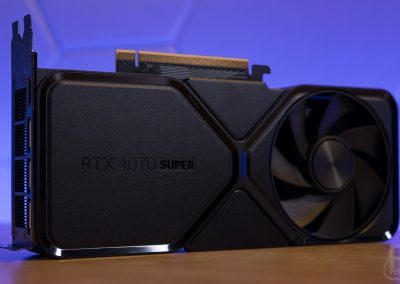NVIDIA GeForce RTX 4070 Super Founders Edition Review

The Return of the SUPER Cards
RTX SUPER cards are back after skipping a generation, and we have a Founders Edition of the new GeForce RTX 4070 SUPER on hand. At $599 USD this takes the place of the original GeForce RTX 4070, which remains in the lineup with a very modest $50 price drop to $549 ($50 above AMD’s Radeon RX 7800 XT at $499, by the way).
The upcoming GeForce RTX 4070 Ti SUPER (yes, it is both a Ti and a SUPER at the same time) will replace the original RTX 4070 Ti at $799 USD, and the RTX 4080 SUPER replaces the vanilla RTX 4080 at a new $999 USD price point. Why the RTX 4070 won’t be taking the $499 USD spot previously occupied by the RTX 4060 Ti 16GB – which is apparently EOL – is a mystery that scientists hope to one day solve.
Note the absence of the GeForce RTX 4060 Ti 16GB on the official slide above. Where is the $499 graphics card??
Anyway, the refresh known as SUPER is back. (And with that, I will take a break from using all caps for “SUPER”.) We need to go back to July of 2019 for the last RTX Super launch, with the RTX 2060 and 2070 Super coming on July 2, 2019, and the RTX 2080 Super arriving a few weeks later on July 23, 2019. That was four and a half years ago! There were no RTX 30 Series Super cards (and considering how NVIDIA was selling every GPU they made, it wasn’t necessary to upgrade the line).
More than simply additions to the lineup, the RTX 40 Series Super cards have replaced their predecessors, with the exception of that original RTX 4070, as we mentioned above.
| RTX 4070 | RTX 4070 SUPER | RTX 4070 Ti SUPER | RTX 4080 SUPER | RTX 4090 | |
|---|---|---|---|---|---|
| GPU | AD104 | AD104 | AD103 | AD103 | AD102 |
| SMs | 46 | 56 | 66 | 80 | 128 |
| CUDA Cores | 5888 | 7168 | 8448 | 10240 | 16384 |
| Tensor Cores | 184 | 224 | 264 | 320 | 512 |
| RT Cores | 46 | 56 | 66 | 80 | 128 |
| Base Clock | 1920 MHz | 1980 MHz | 2340 MHz | 2295 MHz | 2235 MHz |
| Boost Clock | 2475 MHz | 2475 MHz | 2610 MHz | 2550 MHz | 2520 MHz |
| Texture Units | 184 | 224 | 264 | 320 | 512 |
| ROPs | 64 | 80 | 112 | 112 | 176 |
| L2 Cache | 36MB | 48MB | 64MB | 64MB | 72MB |
| Memory | 12GB GDDR6X | 12GB GDDR6X | 16GB GDDR6X | 16GB GDDR6X | 24GB GDDR6X |
| Memory Data Rate | 21 Gbps | 21 Gbps | 22.4 Gbps | 22.4 Gbps | 21 Gbps |
| Memory Interface | 192-bit | 192-bit | 256-bit | 256-bit | 384-bit |
| Memory Bandwidth | 504 GB/s | 504 GB/s | 716 GB/s | 716 GB/s | 1 TB/s |
| Transistor Count | 35.8B | 35.8B | 45.9B | 45.9B | 76.3B |
| Die Size | 294 mm^2 | 294 mm^2 | 379 mm^2 | 379 mm^2 | 609 mm^2 |
| Process Tech | TSMC 4N NV Custom | TSMC 4N NV Custom | TSMC 4N NV Custom | TSMC 4N NV Custom | TSMC 4N NV Custom |
| TGP | 200W | 220W | 285W | 320W | 450W |
| List Price | $549 | $599 | $799 | $999 | $1599 |
Though the new GeForce RTX 4070 Super does have a significant bump in CUDA cores (7168 vs. 5888), the memory system and GPU clock speeds are (largely) unchanged. The RTX 4070 Super uses the same 192-bit interface, and with its 21 Gbps memory it produces the same 504 GB/s of bandwidth as the original RTX 4070.
Check out a handy guide to the differences between the original and SUPER variants of the GeForce RTX 4070 from Corsair (of all places), at this link.
Where things differ are with L2 cache, which moves up to 48MB with the 4070 Super, and GPU clocks. The GPU Boost clock for both versions is 2475 MHz, but the Base clock with the 4070 Super is 60 MHz higher – moving from 1920 MHz to 1980 MHz.
The Founders Edition card we received is nearly identical to the original RTX 4070 Founders Edition, though it has a stealthy all-black exterior:
While it looks identical other than the finish on the metal, the RTX 4070 Super (in addition to higher performance) has a slightly higher TGP rating of 220 watts, up from 200 watts with the original card. This modest increase doesn’t change the requirement of dual PCIe 8-pin connectors for power (using the supplied revised 12VHPWR/12V-2×6 adapter).
Some Test Results
Please note that our GeForce RTX 4070 results come via an overclocked board from MSI, the GeForce RTX GAMING X TRIO 12G, and this is being compared to a stock GeForce RTX 4070 SUPER Founders Edition. Just how much the GPU clocks will affect things remains to be seen, but it’s worth noting.
| PC Perspective GPU Test Platform | ||||||||
|---|---|---|---|---|---|---|---|---|
| Processor | AMD Ryzen 9 7950X (Stock) | |||||||
| Motherboard | MSI MEG X670E ACE Resizable BAR Enabled |
|||||||
| Memory | 32GB (16GBx2) G.Skill Trident Z NEO DDR5-6000 CL30 | |||||||
| Storage | SK Hynix Platinum P41 2TB NVMe SSD | |||||||
| Power Supply | be quiet! Dark Power Pro 12 1500W | |||||||
| Operating System | Windows 11 Pro, 21H2 | |||||||
| Drivers | Adrenalin 22.40.00.57 – 23.20.01.05 GeForce Game Ready Driver 526.72 – 531.42 GRD 546.52 (RTX 4070 SUPER press driver) |
|||||||
3DMark
While seeking testing of a game you actually want to play (and at the resolution and detail level you prefer) is what drives graphics card benchmark traffic, there is still a place for 3DMark. In a perfect, well-optimized world, the cards might behave as shown below.
We begin with a look at Speed Way, a DX12 Ultimate test rendered at 2560×1440:
If every benchmark of the RTX 4070 Super looks like this, NVIDIA might have a hit on their hands. But let’s not get ahead of ourselves.
Next we have Time Spy Extreme, the older DX12 raster test rendered at 3840×2160:
The RTX 4070 Super no longer occupies the second slot, as AMD does quite well in this test, but it isn’t far behind the RTX 4070 Ti. So far, this RTX 4070 Super card looks pretty good.
3440×1440 Ultrawide Benchmarks
Sure, 4K/UHD is the standard nowadays, but consoles connected to living room TVs can do that. What about something that is PC-specific, like 3440×1440 resolution ultrawide monitors? Our own test platform sits next to one such monitor, and that’s how this GPU was tested in a few game benchmarks.
First up (in no particular order) is Cyberpunk 2077, run with ultra detail settings (and no ray tracing or image scaling tech):
Well, in this test the 4070 Super is faster than the original 4070, but that 3 FPS increase isn’t very exciting. To be fair – as mentioned above – in this review we are comparing a Founders Edition 4070 Super to an RTX 4070 with a hefty factory OC (the MSI GeForce RTX 4070 GAMING X TRIO), and the GPU clock bump clearly factors in here. We will have to revisit this with Founders vs. Founders.
Also, finishing behind the less expensive Radeon RX 7800 XT is probably not what NVIDIA was hoping for here. It’s one game at one detail level and resolution, but still.
Next up is Metro Exodus Enhanced Edition, run at the punishing Extreme preset:
This DX12 Ultimate benchmark again showcases the potential of the RTX 4070 Super, which is particularly well-suited to ray traced applications with its increased RT and Tensor core counts compared to the original.
Next up is Far Cry 6, run at the Ultra preset with HD textures enabled:
Far Cry 6 likes Radeon cards, and it seems to like memory bandwidth. Once again, we have a less than exciting result for the RTX 4070 Super considering its $599 price level, at least in a raster-based title like this.
Next up is F1 22, a DX12 Ultimate title run at the Ultra preset with TAA only (no DLSS):
A much better result for the RTX 4070 Super here, once again in a game that can make use of the improved ray tracing performance of the new GeForce card.
Though our testing is thus far limited, in game benchmarks the RTX 4070 Super did not exhibit the same advantage over its predecessor that we saw in 3DMark Speed Way, where it seemed like the card would fall just short of the RTX 4070 Ti. We need to add some new games, but that’s it for now. I think we need to test Founders vs. Founders, or check out an overclocked RTX 4070 Super, to see how core clocks might affect these results.
Finally, we will take a look at power draw from this Founders Edition card:
The RTX 4070 Super lives mostly in the 200 – 240 watt range under load in the 3DMark Speed Way benchmark, peaking at just over 250 watts.
Final Thoughts
While an improvement over the original – and generally more so than in this comparison with an overclocked RTX 4070 – the new GeForce RTX 4070 SUPER does not always reach the heights that a 20% CUDA core increase (7168 vs. 5888) might suggest. The card is powered by the same AD104 GPU, albeit a more enabled one, but is limited to the 192-bit memory system of the original RTX 4070. With 21 Gbps memory this means we have the same bandwidth, but the new card does have 48MB of L2 cache, up from 36MB with the original.
I still have to wonder how much better this card could have performed with some faster memory (and a Boost clock bump), and if there is some actual overclocking headroom I’ll be happy to follow up with more testing. As it is, the GeForce RTX 4070 SUPER does represent a better value than the original at the same $599 USD price point, but the upcoming RTX 4070 Ti SUPER promises to be a far more interesting entry into the lineup.
Review Disclosures
This is what we consider the responsible disclosure of our review policies and procedures.
How Product Was Obtained
The product was provided by NVIDIA for the purpose of this review.
Company Involvement
[Company] had no control over the content of the review and was not consulted prior to publication.
PC Perspective Compensation
Neither PC Perspective nor any of its staff were paid or compensated in any way by NVIDIA for this review.
Advertising Disclosure
NVIDIA has not purchased advertising at PC Perspective during the past twelve months.
Affiliate Links
If this article contains affiliate links to online retailers, PC Perspective may receive compensation for purchases through those links.






















is it worth dropping 100$ more for a very small performance boost over the 7800xt
I’d say it depends on your preferences. Is the ray tracing performance worth the extra cash and do you generally prefer NVIDIA over AMD or are you indifferent?